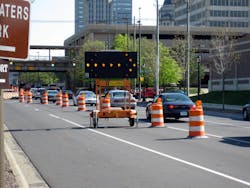States gain control by saying 'no' to federal transportation money
Though radically rethinking funding strategies that have been in place for decades is by no means easy, it’s being considered by some in state governments as the only way to bring the U.S. freight transportation network back up to full speed.
At the recent Infrastructure for the Future summit in Washington D.C., sponsored by the American Highway Users Alliance and the Volvo Group, most of the participants agreed on the need for more revenues to both maintain and expand transportation infrastructure in America.
Yet some also noted that traditional top-down federal management of transportation – especially in terms of motor fuel taxes that generate funds for infrastructure needs – is not only inadequate for the job, federal management of transportation projects is in many ways increasing the cost burden.
“Federal money is in many ways ‘tainting’ many of our projects, as when you accept federal dollars you must accept federal rules as well,” noted Sean Connaughton, outgoing secretary of transportation for the Commonwealth of Virginia. “For example, we had a project in Virginia Beach we recently completed at 60% of the original estimate and part of the reason we saved 40% is that no federal funding was involved. We got it done cheaper and faster without it.”
That’s but one reason why states are getting more directly involved in raising transportation funds through their own tax initiatives, tolling plans, and public private partnerships or “P3” deals, he added, in part due to better cost control but also because of the ripple effects caused by a lack of transportation investment.
“By state law, the first monies that come in for transportation go to maintenance before becoming capital to fund expansion,” Connaughton explained. “But starting in 2002, we started to lose capital dollars to our maintenance needs as funding levels shrank. Over 10 years [2002-2012] $3.2 billion went from our capital fund to our maintenance fund.”
That didn’t just impact Virginia’s transportation strategy, he stressed. “We got a big wakeup call when the ratings agencies put our state on negative watch due to our transportation funding issues; and we’ve had a AAA rating since the Great Depression,” he said.
“Another big wakeup call came when we saw our ratings slip as a business-friendly state due to transportation; that’s because 40% of our [state] economy is based on transportation services for manufacturing and agriculture” Connaughton added. “So our decision to address transportation funding and reform transportation taxes were done consciously so we as a state could remain in a better competitive position.”
Those factors helped drive Virginia to implement a transportation-dedicated sales tax this year, he pointed out, which is expected to generate $6 billion over the next six years. “We tried everything; tolls, an infrastructure bank, every idea you can think of to raise money for transportation – and at the end of the day, even with all of these things, we were still going to run out of money,” Connaughton said. “That’s why reformed the tax structure.”
In terms of road pacing funds alone, that makes a big difference, he explained. Whereas in previous years a maximum of $200 million to $250 million could be dedicated annually to paving projects, with the new tax funds, Virginia can boost that figure to $500 million a year. “We also now can dedicate money to specific bridge projects as well,” Connaughton said.
David Parkhurst, staff director and general counsel for the National Governors Association (NGA), stressed that similar factors are driving other states to alter their transportation strategies as well.
“Four states have raised their fuel taxes – Maryland for example raised its fuel taxes by 12 cents which will add $4 billion in transportation funds,” he said. “Others are exploring alternative tax strategies, like Oregon, which is testing a VMT [vehicle miles traveled] program that Washington state is also going to try.”
Parkhurst added that 33 states and Puerto Rico are now actively involved in P3 efforts as well to help expand their transportation infrastructure.
“The states provide half of all transportation funding in the U.S. and a growing number of them are not waiting for the federal government to ride to the rescue,” he said. “Without a doubt, the consensus among state governors is that infrastructure is a national issue and responsibility. While we’re not advocating for federal disengagement, as there’s only so much states can do constitutionally, the states aren’t waiting – they can’t wait.”
About the Author
Sean Kilcarr
Editor in Chief
Sean Kilcarr is a former longtime FleetOwner senior editor who wrote for the publication from 2000 to 2018. He served as editor-in-chief from 2017 to 2018.
